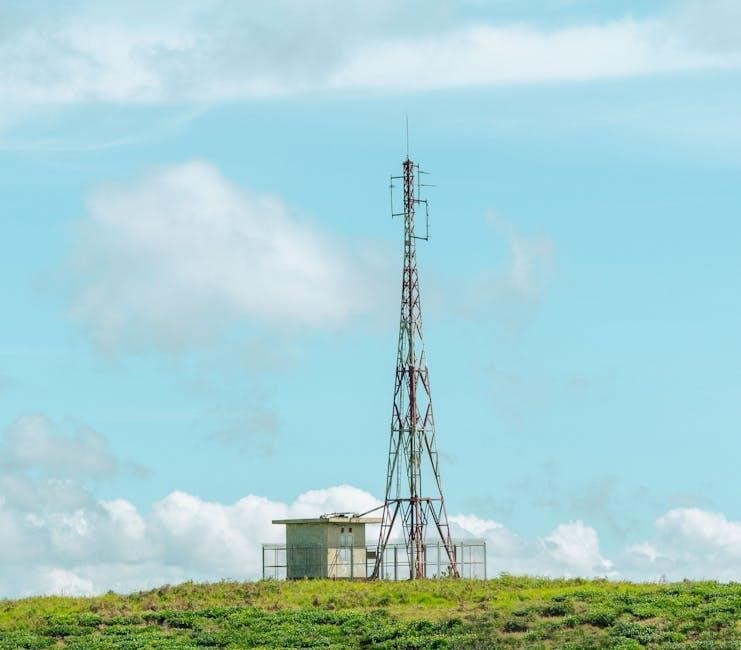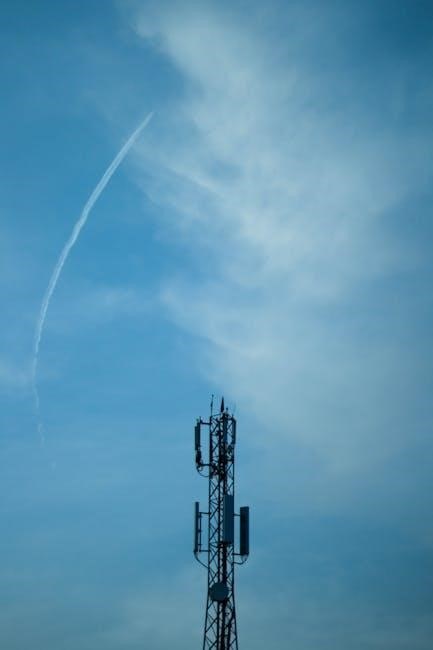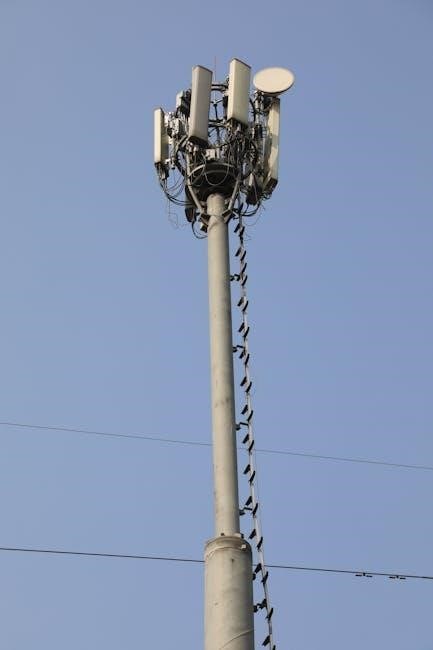Cell phone towers are essential for wireless communication, supporting antennas, transceivers, and other critical components. They ensure reliable network coverage, connecting millions globally.
1.1. Overview of Cell Phone Towers
Cell phone towers, also known as cellular base stations, are tall structures designed to support antennas, transceivers, and other essential equipment. These towers enable wireless communication by transmitting and receiving signals between devices and networks. They are typically equipped with antennas mounted at heights to ensure wide coverage areas. The towers house base transceiver stations (BTS) that process signals and connect calls. Additionally, they include power supplies, climate control systems, and transmission lines to ensure continuous operation. Cell towers are categorized into types like monopoles, guyed towers, and lattice towers, each serving specific purposes based on location and requirements. Their design and components are critical for maintaining reliable communication networks.
1.2. Importance of Cell Towers in Communication
Cell towers are indispensable for modern communication, enabling wireless connectivity across vast areas. They support antennas and transceivers, facilitating voice calls, data transmission, and internet access. By providing high-height platforms for signal transmission, towers ensure reliable coverage in urban and rural areas. They are crucial for emergency services, navigation, and remote work, underpinning global communication networks. The deployment of 5G and IoT technologies further highlights their importance in advancing connectivity. Without cell towers, seamless wireless communication would be impossible, making them a cornerstone of today’s connected world. Their role in maintaining network reliability and accessibility cannot be overstated.
Key Components of Cell Phone Towers
Cell towers consist of antennas, transceivers, power systems, and climate control units. These components ensure reliable signal transmission, processing, and distribution for seamless communication networks.
2.1. Antennas and Mounting Equipment
Antennas are crucial components of cell towers, transmitting and receiving radio frequency signals. They are typically mounted on the tower using sturdy equipment, such as U-Bolts and brackets, to ensure stability. The antennas are positioned strategically to maximize coverage and minimize interference. Mounting hardware varies depending on the type and number of antennas, ensuring secure attachment and optimal performance. Proper installation of both antennas and their mounting systems is essential for maintaining signal strength and reliability, making them a cornerstone of effective communication infrastructure.
2.2. Base Transceiver Station (BTS)
The Base Transceiver Station (BTS) is a critical component of cell towers, responsible for transmitting and receiving voice and data signals. Located at the base or near the tower, the BTS houses transceivers, digital signal processors, and control electronics. These components manage the communication between mobile devices and the network, ensuring seamless connectivity. The BTS connects to antennas via transmission lines and fiber optic cables, enabling efficient signal distribution. It also integrates with power supply systems and climate control mechanisms to maintain optimal operating conditions, ensuring reliable performance and uninterrupted service delivery to users within its coverage area.
2.3. Transmission Lines and Fiber Optic Cables
Transmission lines and fiber optic cables are vital for connecting the BTS to antennas, enabling high-speed data transmission. Coaxial cables and fiber optics ensure signal integrity, while RF filters and splitters optimize performance. These components minimize interference, ensuring clear communication. Fiber optic cables provide high bandwidth for 5G and IoT integration, while transmission lines support voice and data services. Together, they maintain seamless connectivity, enabling efficient network operations and reliable service delivery across various frequencies and technologies.
2.4. Power Supply and Backup Systems
Power supply and backup systems are critical for ensuring uninterrupted operation of cell towers. Primary power is typically provided by mains electricity, while backup systems, such as diesel generators and battery banks, kick in during outages. These systems are essential for maintaining service reliability, especially in remote areas. Advanced towers also incorporate UPS (Uninterruptible Power Supply) systems to provide immediate backup during power transitions. Additionally, renewable energy sources like solar panels are increasingly being integrated to reduce operational costs and environmental impact. These power solutions ensure continuous functionality of antennas, BTS, and other critical components, safeguarding communication networks from disruptions.
2.5. Climate Control Systems (Heating/Cooling)
Climate control systems are essential for maintaining optimal operating temperatures within cell towers. These systems ensure that electronic equipment, such as the BTS and transmission gear, functions reliably under varying environmental conditions. Heating systems are used in colder climates to prevent equipment from freezing, while cooling systems, including air conditioning and heat exchangers, are employed in warmer regions to prevent overheating. Proper temperature regulation extends the lifespan of components and prevents service disruptions. Additionally, some modern towers incorporate energy-efficient solutions, such as free cooling systems, to reduce power consumption while maintaining performance. These systems are critical for ensuring continuous network reliability and operational efficiency.

Types of Cell Phone Towers
Cell towers vary in design, including monopoles, guyed, lattice, and camouflaged towers. Each type serves specific needs, ensuring reliable connectivity while adapting to environmental and aesthetic requirements.
3.1. Monopole Towers
Monopole towers are the most common type of cell tower, known for their sleek, single-pole design. They are typically tall, slender structures that support antennas and other essential equipment. These towers are preferred in urban areas due to their minimal visual impact and ease of installation. Monopole towers are constructed using durable materials like steel and can be customized to blend with their surroundings, making them a popular choice for modern communication needs. Their design allows for efficient signal transmission and reception, ensuring reliable connectivity for mobile users.
3.2. Guyed Towers
Guyed towers are tall, narrow structures supported by guy wires anchored to the ground. They are often used in remote or rural areas where their height can cover large distances. These towers are cost-effective and can support multiple antennas, making them versatile for various communication needs. The central mast is secured by tensioned wires, providing stability and strength. Guyed towers are ideal for locations requiring extensive coverage but may require more land due to the spacing needed for the guy wires. They are a practical solution for expanding wireless networks in challenging terrains.
3.3. Lattice Towers
Lattice towers are robust structures with a framework of interlocking metal strips, forming a strong yet lightweight design. They are highly durable and resistant to harsh weather conditions, making them ideal for challenging environments. These towers are often used in urban areas due to their ability to support multiple antennas and equipment. While they can be visually intrusive, their strength and versatility make them a popular choice for high-capacity communication needs. Lattice towers are typically taller than other types, ensuring wide coverage and reliable signal transmission in densely populated regions.
3.4. Camouflaged Towers
Camouflaged towers are designed to blend seamlessly into their surroundings, minimizing visual impact. Often disguised as trees, flagpoles, or buildings, these towers are ideal for urban and sensitive areas. Their unique design helps preserve aesthetics while maintaining functionality. Constructed with materials that mimic natural or man-made structures, they reduce opposition from communities. Despite their concealed appearance, they support all necessary components like antennas and transceivers. This innovative approach ensures efficient communication while respecting environmental and architectural harmony. Camouflaged towers are a practical solution for modern communication needs in visually sensitive locations.
3.5. Mobile Cell Towers
Mobile cell towers are portable structures designed for temporary or emergency communication needs. They are easily transportable and can be rapidly deployed in areas with limited infrastructure or during events like festivals or disasters. These towers are equipped with antennas, transceivers, and power systems, ensuring quick establishment of network coverage. Their compact design and self-contained components make them versatile for various scenarios. Mobile towers are crucial for providing reliable connectivity in remote or disaster-stricken regions, offering flexibility and efficiency. They play a vital role in maintaining communication services where permanent towers are unavailable or impractical. Their adaptability makes them indispensable in modern telecommunications.

Structural Design and Engineering
Structural design ensures towers withstand environmental stresses, with foundation plans, robust materials, and precise load calculations to maintain stability and safety. Engineering excellence is critical.
4.1. Foundation Design for Stability
Foundation design is critical for cell tower stability, ensuring durability against environmental stresses. Deep foundations or spread footings are used based on soil conditions and tower height. Advanced design models simulate wind, seismic, and weight loads to optimize foundation strength. Proper drainage and material selection prevent erosion and degradation. Reinforced concrete and steel are common materials due to their durability. The foundation must also accommodate transmission lines and power systems. Engineers conduct soil tests to determine the best design approach, ensuring the tower remains stable over its lifespan. A well-engineered foundation minimizes risks of structural failure, safeguarding both equipment and surrounding areas.
4.2. Materials Used in Tower Construction
Cell towers are constructed using durable materials to withstand environmental conditions. Steel is the primary material due to its high strength-to-weight ratio and resistance to corrosion. Concrete foundations are often used for stability, while fiber optic cables ensure high-speed data transmission. Aluminum and galvanized steel are preferred for antennas and mounting equipment because they offer corrosion resistance and lightweight durability. Polycarbonate or fiberglass materials are used for enclosures to protect electronic components from weather. These materials ensure the tower’s structural integrity, longevity, and optimal performance in various climates. The choice of materials is critical to maintaining reliable communication networks and minimizing maintenance needs over time.
4.3. Load Calculations and Safety Standards
Load calculations are critical to ensure cell towers can withstand environmental stresses like wind and ice. Engineers use structural analysis models to determine the weight and stress distribution of antennas, transceivers, and other components. Safety standards, such as those set by the Telecommunications Industry Association (TIA), guide the design and construction process. These standards ensure towers can endure extreme weather conditions while maintaining structural integrity. Regular inspections and compliance with local building codes further enhance safety. Load calculations and safety standards are essential to prevent failures and guarantee reliable communication networks, protecting both the infrastructure and public safety over time.

Antenna Systems and Accessories
Antennas are crucial for transmitting and receiving signals, with types including whip, sector, and directional antennas. Accessories like splitters, couplers, and attenuators optimize signal distribution and strength.
5.1. Types of Antennas Used
Cell phone towers utilize various antenna types to ensure efficient communication. Whip antennas are simple and compact, often used for basic signal transmission. Sector antennas, Meanwhile, are directional, providing focused coverage to specific areas, enhancing signal strength and reducing interference. Directional antennas are designed for point-to-point communication, ideal for connecting distant towers. Omni-directional antennas offer 360-degree coverage, making them suitable for urban areas with widespread signal needs. Each antenna type is chosen based on the tower’s location, intended coverage area, and signal requirements, ensuring optimal network performance and reliability for users.
5.2. Signal Splitters, Couplers, and Attenuators
Signal splitters, couplers, and attenuators are essential components in cell phone towers for managing and distributing RF signals. Splitters divide signals evenly between multiple antennas, ensuring uniform coverage. Couplers combine signals from different sources, optimizing transmission efficiency. Attenuators reduce signal strength where necessary, preventing overload or interference. These devices are critical for maintaining signal integrity, ensuring clear communication, and preventing signal loss. Proper installation and configuration of these components are vital for seamless network operation, enabling towers to support high-quality voice and data transmission across various frequencies and bandwidths.
5.3. Mounting Hardware and Accessories
Mounting hardware and accessories are crucial for securely attaching antennas and other equipment to cell phone towers. These include brackets, clamps, and fasteners designed to withstand environmental stresses. U-Bolts, U-clamps, and mounting pipes are common, ensuring stable antenna installation. Accessories like adapters and connectors facilitate integration of various components. Durable materials, such as stainless steel and galvanized steel, are used to prevent corrosion. Proper mounting ensures optimal signal transmission and reception, while minimizing interference. Safety and structural integrity are prioritized through robust hardware designs, enabling reliable network performance and longevity of the tower system.

Transmission and Reception Systems
Transmission and reception systems in cell towers involve transceivers, digital signal processors, and control electronics. These components manage signal transmission, ensuring clear communication and optimal network performance.
6.1. Transceivers and Digital Signal Processors
Transceivers and digital signal processors are crucial components in cell towers, handling both transmission and reception of signals. Transceivers convert electrical signals to radio waves and vice versa, enabling communication between devices and the network. Digital signal processors enhance signal quality by filtering noise, correcting errors, and optimizing data transmission. They work together to ensure reliable and high-speed connectivity, supporting advanced technologies like 5G. These components are essential for maintaining seamless communication and are often integrated into the Base Transceiver Station (BTS) for efficient operation.
6.2. Control Electronics and Monitoring Systems
Control electronics and monitoring systems are vital for managing cell tower operations. These systems include advanced software and hardware that monitor signal strength, temperature, and power levels. They ensure optimal performance by automatically adjusting settings and detecting faults. Remote monitoring capabilities allow technicians to troubleshoot issues without physical visits. Sensors embedded in the tower track environmental conditions like humidity and structural integrity. These systems also manage power distribution and interface with other components, ensuring reliability and safety. They play a key role in maintaining network uptime and efficiency, enabling proactive maintenance and minimizing service disruptions.
Safety and Regulatory Compliance
Cell phone towers must adhere to strict safety and regulatory standards. Regular inspections ensure compliance with international codes, guaranteeing structural integrity and operational safety. Certifications and environmental regulations are meticulously followed.
7.1. Safety Standards for Tower Construction
Safety standards for cell phone tower construction are critical to ensure structural integrity and operational reliability. These standards include rigorous structural analysis models for tower design, focusing on foundation stability and load calculations. Materials used must meet specific durability requirements to withstand environmental conditions. Regular inspections and certifications are mandated to verify compliance with international safety codes. Proper installation and maintenance practices are enforced to prevent accidents and ensure long-term functionality. Additionally, environmental regulations are integrated into construction protocols to minimize ecological impact. Compliance with these standards guarantees the safety of both the tower and surrounding areas, ensuring reliable communication services.
7.2. Regulatory Requirements for Tower Installation
Regulatory requirements for cell tower installation ensure compliance with local, state, and federal laws. Permits are mandatory, and towers must meet engineering standards for structural stability and environmental impact. Environmental impact assessments are often required to minimize ecological disruption. Zoning laws dictate placement, ensuring towers align with community aesthetics and safety norms. Radiofrequency emission standards must be met to safeguard public health. Public consultations may be necessary to address community concerns. Compliance with these regulations ensures lawful operation and minimizes potential legal or environmental issues, balancing technological advancement with societal and ecological considerations.

Maintenance and Upgradation
Maintenance involves routine checks and hardware upgrades to ensure optimal performance. Regular cleaning of antennas and replacement of outdated systems enhance reliability and adaptability to new technologies.
8.1. Regular Maintenance Practices
Regular maintenance ensures cell towers operate efficiently and reliably. This includes cleaning antennas, inspecting transceivers, and testing signal strength. Technicians also check fiber optic cables and power systems for faults. Routine inspections identify wear and tear, such as rust or loose connections, which are repaired promptly. Software updates are performed to enhance performance and security. Additionally, backup power systems are tested to ensure reliability during outages. Proper maintenance minimizes downtime and ensures seamless communication services. These practices are critical for maintaining network integrity and user satisfaction in an increasingly connected world.
8.2. Upgrading Tower Components
Upgrading cell tower components is crucial for adapting to advancing technology and increasing demand. This includes replacing outdated antennas with high-capacity models and installing modern transceivers to support faster data rates. Fiber optic cables are often upgraded to improve signal transmission speed and reliability. Additionally, software updates are performed to enhance system performance and security. Power systems may be upgraded to support higher energy demands, while cooling systems are improved to maintain optimal operating temperatures. These upgrades ensure towers remain efficient and capable of handling emerging technologies like 5G. Regular component upgrades are essential for maintaining network performance and meeting growing user expectations.
Environmental Impact and Considerations
Cell towers’ environmental impact includes visual intrusion and ecological effects. Assessments ensure minimal disruption, while camouflaged designs reduce visual footprint, addressing community and wildlife concerns effectively.
9.1. Environmental Impact Assessment
Environmental Impact Assessments (EIAs) evaluate cell tower deployment’s ecological and aesthetic effects. They analyze placement, emissions, and visual intrusion, ensuring minimal disruption. Assessments consider wildlife habitats, noise levels, and land use. Mitigation strategies, like camouflaged towers or alternative locations, are often implemented. EIAs also address public concerns, such as health risks from RF emissions, though studies show levels are within safe limits. The goal is to balance connectivity needs with environmental preservation, ensuring sustainable development. Regulatory compliance and community engagement are key components of this process, fostering responsible infrastructure growth while protecting natural and urban landscapes.
9.2. Minimizing Visual and Ecological Footprint
Minimizing the visual and ecological impact of cell towers involves innovative design and strategic placement. Camouflaged towers, such as those disguised as trees or buildings, reduce their visual presence. Designers also use materials and colors that blend with surroundings. Ecologically, measures like avoiding sensitive habitats and using energy-efficient systems reduce the footprint. Towers are often placed in existing infrastructure to limit land use. Additionally, modular designs allow for easier upgrades, reducing long-term environmental disruption. These strategies ensure connectivity while preserving natural and urban landscapes, addressing both aesthetic and ecological concerns effectively.
Future Trends in Cell Tower Technology
Future trends include transitioning to 5G and beyond, integrating IoT for smart cities, and enhancing energy efficiency in tower operations to support advanced connectivity demands globally.
10.1. 5G and Beyond
The transition to 5G and beyond is revolutionizing cell tower technology, requiring higher frequency bands and advanced antenna systems. Towers now integrate massive MIMO (Multiple Input Multiple Output) and beamforming technologies to enhance capacity and coverage. The rollout of 5G necessitates denser networks, leading to the deployment of small cells and micro towers. Additionally, the use of fiber optic cables is expanding to support the high-speed data transfer demands of 5G. Energy-efficient solutions, such as solar-powered towers, are also being adopted to reduce operational costs. As 5G matures, it will enable seamless integration with emerging technologies like IoT and AI, driving smarter and more connected communities globally.
10.2. Integration with IoT and Smart Cities
Cell phone towers are pivotal in enabling IoT and smart city initiatives by providing the necessary connectivity for millions of interconnected devices. As IoT expands, towers must support low-power wide-area networks (LPWAN) and edge computing to handle vast data streams. Smart cities leverage tower-mounted sensors for traffic management, environmental monitoring, and public safety. The integration of IoT with cell towers enhances urban efficiency, enabling real-time data exchange for applications like smart lighting, waste management, and energy grids. This convergence ensures seamless communication, driving innovation and sustainability in urban environments while supporting the growing demand for connected solutions globally.
Cell phone towers are critical infrastructure for modern communication, enabling seamless connectivity and data transmission. Their components, including antennas, BTS, and power systems, ensure reliable service. As technology advances, towers adapt to support 5G and IoT, enhancing smart city initiatives and global communication networks. Their evolution underscores their vital role in connecting societies and driving technological progress.



